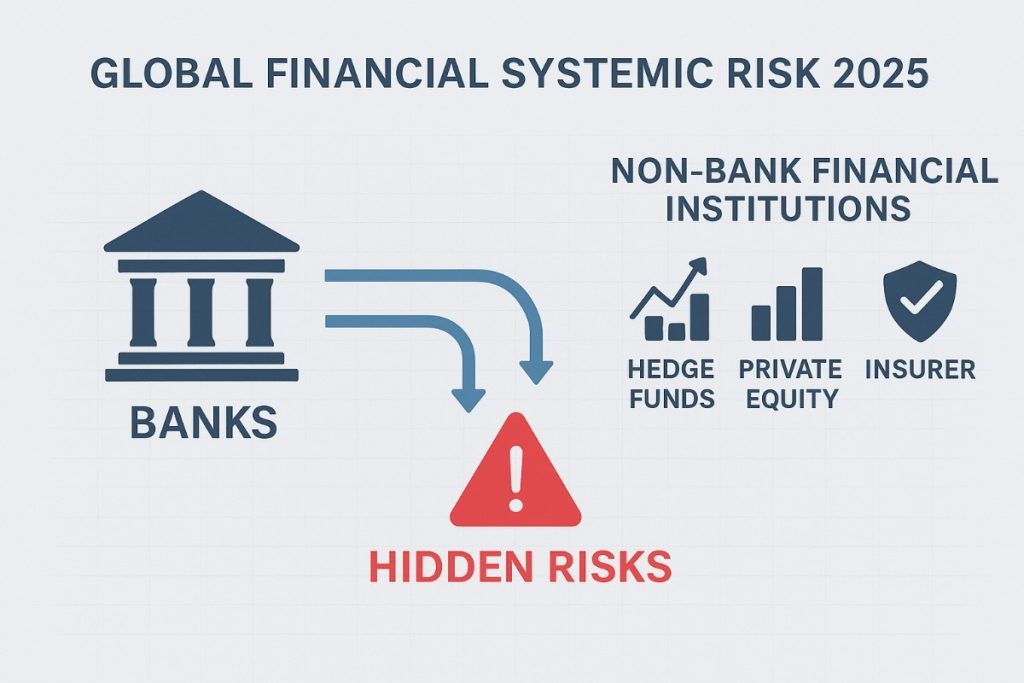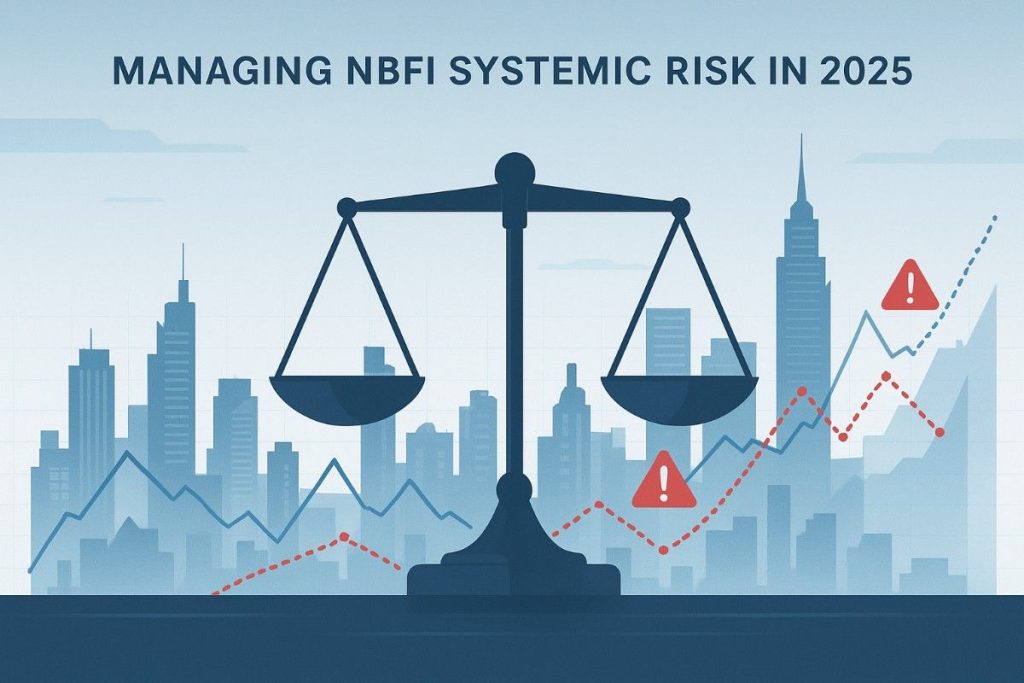NBFIs Systemic Risk in 2025: Impact on Global Financial Stability
Non-bank financial institutions (NBFIs) play a growing role in credit markets. In 2025, NBFIs systemic risk has become a central concern because they operate outside traditional banking safety nets. Unlike banks, NBFIs do not have direct access to central bank liquidity, which makes them more vulnerable during stress. This vulnerability increases the chance of instability across markets. For investors, policymakers, and financial professionals, understanding the risks of shadow banking and private credit is now essential to protecting global financial stability.
Understanding Non-Bank Financial Institutions
What NBFIs Are and How They Differ from Banks
NBFIs include hedge funds, private equity firms, insurance companies, and finance companies. They provide lending and investment services outside conventional banks, often filling gaps left by traditional lenders. The key difference is that they do not take deposits or benefit from government-backed protections. This leaves them exposed to liquidity mismatches and limits their ability to withstand sudden shocks. Because oversight is limited, the potential for contagion increases.
Shadow Banking and Global Market Exposure
Shadow banking describes lending and credit activities carried out by NBFIs outside traditional rules. These activities often rely on leverage, complex financial products, and strategies that lack transparency. If markets turn volatile, weaknesses can spread quickly. By 2025, the scale of shadow banking has grown sharply. NBFIs now hold large positions in leveraged loans and structured credit products, linking them more closely to banks and other financial institutions. This interconnectedness raises the risk of contagion.
Private Credit Growth and Hidden Vulnerabilities
Private credit has expanded as companies and investors seek financing beyond banks. While this supports capital access, it carries risks. Direct lending, limited transparency, and illiquid assets make the sector fragile.

Concentrated exposures and weak oversight raise the likelihood of defaults and market stress. These dynamics suggest that private credit growth in 2025 could fuel a wider credit bubble, creating vulnerabilities that are difficult to manage.
How Non-Bank Lenders Amplify Instability
Market Contagion Channels
Non-bank lenders extend credit across many sectors, but their reliance on short-term funding and securitization makes them sensitive to downturns. When markets tighten, problems spread quickly, transmitting shocks far beyond the non-bank sector. The volatility of leveraged loans and the ties between NBFIs and traditional banks show how local disruptions can escalate into global instability.
Hidden Leverage in Direct Lending
Hidden leverage is one of the most pressing concerns in the non-bank sector. Borrowing and derivatives are often underreported, leaving risks out of public view. Direct lending in private credit lacks the protections banks apply, which creates dangers if borrowers default or liquidity dries up. Combined with shadow banking activity, these risks form multiple layers of systemic exposure. In 2025, this mix represents a critical challenge to financial stability.
Global Credit Bubble Concerns in 2025
The rapid growth of credit through non-banks is raising alarms about a potential global bubble. Excessive leverage, rising defaults, and ongoing uncertainty could create widespread disruption. While early stress may appear in non-bank institutions, their close connections to banks mean the damage would spill quickly into the broader system. To prevent this, regulators and investors must monitor credit expansion patterns and liquidity mismatches more closely.
Regional Exposure to Non-Bank Risks
United States
The U.S. has the world’s largest shadow banking sector. Its private credit markets and leveraged loan activity expose investors to shocks. Regulators face pressure to strengthen oversight of liquidity risks and close regulatory gaps.
UK and Europe
Both regions face similar challenges. The UK’s shadow banking market remains under review, while Europe works to balance alternative lending growth with stability measures. Stronger supervision aims to prevent contagion during stress.
UAE and Gulf
Private credit expansion has accelerated across the Gulf, led by the UAE. Institutional demand for higher yields drives this growth but also increases vulnerabilities. Policymakers must manage the balance between growth and resilience.
Asia-Pacific
The region is experiencing a surge in non-bank lending. Expanding shadow banking and private credit create leverage and liquidity risks. Countries including Singapore, Japan, India, and China are strengthening safeguards to reduce contagion.
Regulation and Oversight in 2025
IMF and FSB
Both the IMF and the Financial Stability Board call for coordinated global action. Reports warn that unchecked private credit growth and shadow banking could undermine stability.
BIS Warnings
The Bank for International Settlements highlights rising leverage and liquidity mismatches outside banks. It warns that cross-border links between banks and NBFIs could spread shocks.
Closing Regulatory Gaps
Current frameworks remain behind market innovation. Weak oversight allows excessive risk-taking, amplifying vulnerabilities. Closing these gaps is essential to protecting financial systems worldwide.
Investment Implications
Risks for Investors
Institutional and retail investors face exposure to volatility from shadow banking and private credit. Awareness of these risks is critical for portfolio protection.
Diversification
Portfolios that move beyond NBFI-linked assets are more resilient. Including low-correlation assets helps manage systemic risks.
Safe Haven Assets
Bonds, high-quality corporate debt, and other defensive allocations provide stability when markets are under stress.
Contradictions and Future Outlook
NBFIs are expanding faster than regulators can respond, creating a tension between innovation and safety. Their global reach raises the risk of contagion across borders. Stability requires stronger rules, greater transparency, and international cooperation.
Strategies for Policymakers and Investors
- Track risks continuously by monitoring shadow banking and private credit.
- Stress test portfolios to measure resilience under liquidity or leverage stress.
- Balance risk and return with defensive allocations suited to uncertain conditions.
FAQs
What are NBFIs and why are they risky?
They are financial entities operating outside banks. Because they rely on leverage and lack safety nets, they are more vulnerable to shocks.
How do NBFIs create systemic risk?
They extend credit through fragile structures. When stress occurs, these weaknesses spread contagion across markets.
Which regions face the most exposure?
The U.S., UK, UAE, and Asia-Pacific carry the highest risks due to the size and growth of private credit and shadow banking markets.
What strategies can investors use?
Diversification, portfolio stress testing, and safe-haven allocations help reduce exposure.
Conclusion
In 2025, NBFIs systemic risk is one of the most significant threats to financial stability. Their growth in shadow banking and private credit exposes weaknesses that regulation has not fully addressed.

Policymakers must strengthen oversight, while investors need strategies that protect returns and reduce vulnerabilities. By monitoring trends, applying defensive measures, and preparing for hidden leverage risks, regulators and market participants can navigate challenges more effectively.
